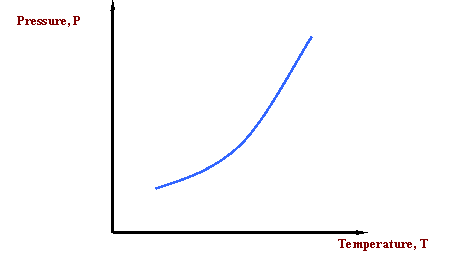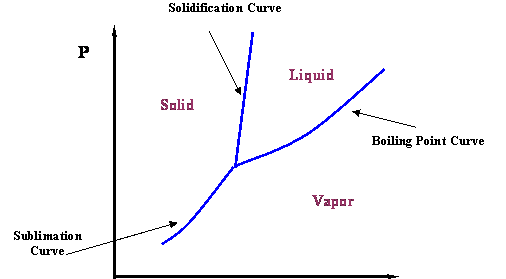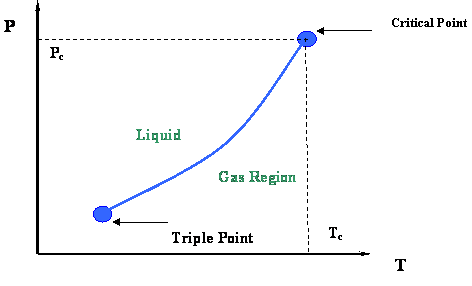Let us start with a well-known single component system: water — the most plentiful substance on earth. What is the behavior of water under different conditions of pressure and temperature? Or even more specific, is there a single answer to the question: what is the boiling point of water? Most people would say, “of course, 100 °C”, but a more accurate response would pose a clarifying question: “At what pressure?” It is common knowledge that water boils at 100 °C (212 °F) at atmospheric pressure. By requiring a pressure specification in order to uniquely define the boiling point of water, we are acknowledging that the boiling temperature of a pure substance is pressure-dependent. In reality, we are also implicitly applying a very useful thermodynamic principle, the Gibbs Rule, but this will be the topic for later discussion.
In thermodynamics, we refer to the Normal Boiling Point as the boiling temperature of a fluid at 1 atm of pressure (that is, atmospheric pressure.) Therefore, 100 °C (212 °F) is the normal boiling point of water.
What if we want to communicate this idea? We would like to communicate the concept that the temperature at which water boils varies with pressure. What about a picture to represent this information? Here is our first phase diagram, Figure 2.1. Whereas several sentences may be required to describe the variability of the boiling point of water, the single line shown in Figure 2.1 is adequate. What does Figure 2.1 tell us? It tells us that the boiling temperature of a liquid increases as pressure increases. In other words, it says that the vapor pressure of a liquid increases as temperature increases. That is to be expected because as the temperature increases, more liquid molecules are able to escape into the vapor phase, thus increasing the pressure that the aggregate of all vapor molecules exerts on the system (i.e. vapor pressure).

The curve in Figure 2.1 is called the vapor pressure curve or boiling point curve. The line also represents the dew point curve and the bubble point curve; one on top of the other. This curve represents the transition between the vapor and liquid states.
Definition of Basic Terms
Vapor Pressure: The pressure that the vapor phase of a fluid exerts over its own liquid at equilibrium at a given temperature.
Dew Point: The pressure and temperature condition at which an infinitesimal quantity of liquid (a droplet) exists in equilibrium with vapor. It represents the condition of incipient liquid formation in an initially gaseous system. Notice that it can be also visualized as a “liquid system” where all but an infinitesimal quantity of liquid has been vaporized.
Bubble Point: The pressure and temperature condition at which the system is all liquid, and in equilibrium with an infinitesimal quantity (a bubble) of gas. This situation is, in essence, the opposite of that of the dew point.
Note:
For single-component systems, one single curve represents all three of these conditions (vapor pressure, dew point and bubble point conditions) simply because Vapor Pressure = Dew Point = Bubble Point for unary systems.
In Figure 2.1, once a saturation pressure has been selected, there is one (and only one) saturation temperature associated with it. This is only true for a single component system. In other words, this is the only temperature (at the given pressure), at which liquid and gas phase will co-exist in equilibrium. The rule that governs the uniqueness of this point, for a single-component system, is called the Gibbs Phase Rule. This is the second time we have mentioned this rule, pointing to its great importance in phase behavior. Let us postpone any detailed discussion of the Gibbs Phase Rule until later.

The vapor curve, shown in Figure 2.1, represents the transition between the vapor and liquid states for a pure component. Obviously, this is not the whole story. If we cool the liquid system, it makes sense to expect ice to form (a solid phase). We can communicate this new idea by adding more information to Figure 2.1. In fact, there is a line that defines the liquid-solid transition; it is called the solidification (or melting) curve (see Figure 2.2). Furthermore, even though it is counter-intuitive, it is possible to go from solid to vapor without going through a liquid state, if the pressure is low enough. This information can be added to the diagram by including the sublimation curve. Thus, Figure 2.2 represents a more complete phase diagram for a pure-component system.
See how more and more information can be represented within the limits of the phase diagram. As petroleum and natural gas engineers, we focus our attention on the Boiling Point Curve, as it represents the transition between liquid and gas, the phases with which we deal most often. Let us focus our attention on it.
Figure 2.3 presents a P-T diagram representing the vapor pressure curve and its extremities. Two very important thermodynamic points bound the vapor pressure curve: the Critical Point at its upper end and the Triple Point at its lower end.

The Triple Point is the meeting point of the vapor pressure, solidification and sublimation curves (see Figure 2.2); hence, it represents the only condition at which all three phases of a pure substance (solid, liquid and gas) can co-exist in equilibrium.
At the Critical Point, gas and liquid are in equilibrium without any interface to differentiate them; they are no longer distinguishable in terms of their properties. As we recall, the only location on the P-T diagram where liquid and gas can be found together in equilibrium is along the vapor pressure curve. Hence, the critical point is clearly the maximum value of temperature and pressure at which liquid and vapor can be at equilibrium. This maximum temperature is called the critical temperature (Tc); the corresponding maximum pressure is called the critical pressure (Pc).
Let us conclude this first module by highlighting the most important properties of the critical point of pure substances, as shown below. The next module will be providing more details of interest that are embedded in Figure 2.3.
Properties Of The Critical Point (Tc,Pc) (For Pure Substances):
- Temperature and pressure for which liquid and vapor are no longer distinguishable.
- For T > Tc, liquid and vapor will not co-exist, no matter what the pressure is.
- For P > Pc, liquid and vapor will not co-exist, no matter what the temperature is.